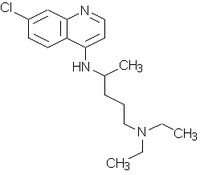Chloroquine
Chloroquine is a commonly used form of medication against malaria. As it also mildly suppresses the immune system, it is used in some autoimmune disorders, such as rheumatoid arthritis. more...
Pharmacology
It has a very high volume of distribution, as it diffuses into the body's adipose tissue.
Mechanism of action
Inside the red blood cells, the parasite must degrade the hemoglobin for the acquisition of essential amino acids, which the parasite needs to survive and multiply inside the cell.
During this process, the parasite produces the toxic and soluble molecule heme. To avoid destruction by this molecule, the parasite aggregates heme to form hemozoin, an insoluble non-toxic molecule. Hemozoin formation is mediated by phospholipids as well as histidine-rich proteins Pfhrp-2 and Pfhrp-3.
Chloroquine interferes with binding of heme to histidine-rich proteins or lipids and prevents the formation of hemozoin, which in turn leaves heme in an uncrystallised form. This has a toxic effect to the parasite, and is therefore killed by this molecule.
The effectiveness of chloroquine against the parasite has declined as some resistant forms of the parasite can effectively neutralize the drug by developing a mechanism that drains chloroquine away from the key area, preventing heme from reaching the necessary concentration.
Against rheumatoid arthritis, it operates by inhibiting lymphocyte proliferation, phospholipase A, release of enzymes from lysosomes, release of reactive oxygen species from macrophages, and production of IL-1.
Read more at Wikipedia.org



